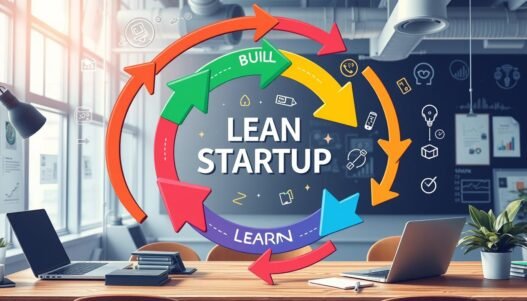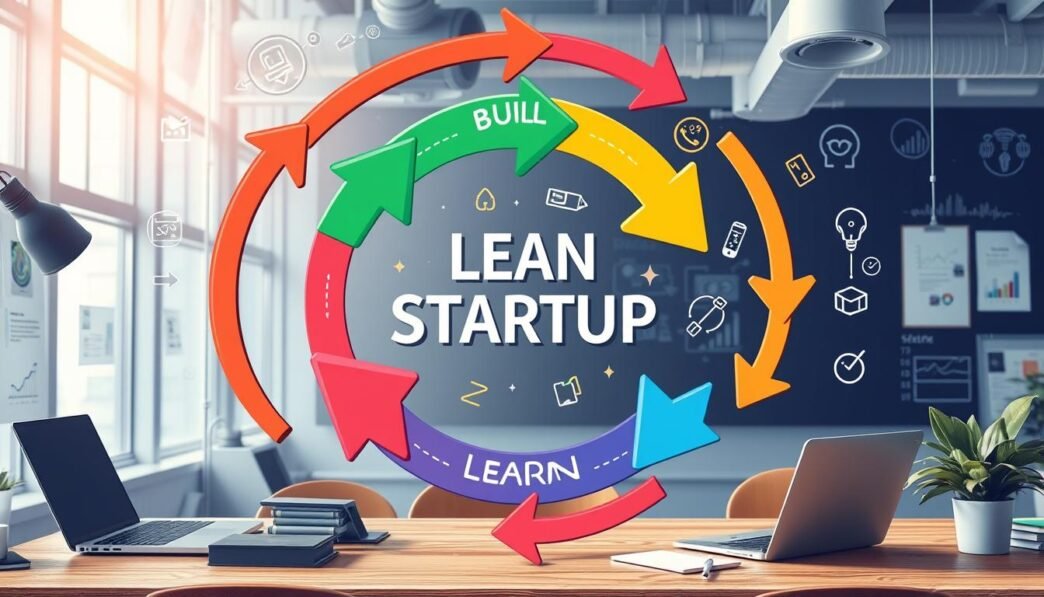Did you know that nearly 75% of startups fail because they don’t listen to their customers? The Lean Startup method is essential for today’s entrepreneurs1. It focuses on making products better through constant feedback and quick changes. This way, startups can manage their resources well and grow efficiently.
Lean Startup teaches entrepreneurs to talk to customers early and test their ideas often. This helps startups avoid launching products that no one wants. By treating their business as an experiment, they can quickly change their plans based on what they learn2. This makes their business more flexible and increases their chances of success.
The Lean Startup method believes that wasting time hurts a startup’s growth. It encourages fast innovation by learning from customers at every step3. As we explore Lean Startup, you’ll see how it changes product development and helps startups connect with their customers better.
Key Takeaways
- The Lean Startup framework significantly decreases the risk of product failure through customer validation.
- Early customer engagement is crucial for developing products that resonate with the market.
- Iterative testing and rapid adaptation are key to efficient resource management.
- Actionable metrics guide entrepreneurs in making informed business decisions.
- The methodology encourages treating segments of the business as experiments.
Understanding the Lean Startup Methodology
The Lean Startup methodology was introduced by Eric Ries in 2008. It changes how new ventures start by focusing on experimenting, testing, and iterating with customer feedback4. It aims to cut down on waste in the early stages of product development. This increases the chances of success without needing a lot of money or detailed plans4.
Startups using this method focus on what customers want. They create a Minimum Viable Product (MVP) to get direct feedback45.
The “Build, Measure, Learn” framework is at the core of this method. It involves making an MVP, checking its feedback, and learning to improve4. Unlike old ways that focus on big plans, the Lean Startup encourages a flexible, iterative process. It’s all about quick learning and adapting to the market45.
Companies like Zappos show how well this works. They used lean strategies early on and were later sold to Amazon for $1.2 billion5. Using the Lean Startup method saves time and money. It also helps businesses grow and succeed in the long run5.
| Key Components | Description |
|---|---|
| Build | Create an MVP to bring your idea to market. |
| Measure | Collect customer feedback and performance data. |
| Learn | Analyze data to iterate on your product and features. |
| Experimentation | Pivot or persevere based on validated learning and market data. |
The Importance of Rapid Innovation
In today’s fast-paced world, rapid innovation is key for startups to grow. Companies all over are looking for ways to innovate quickly and well. This lets them keep up with fast-changing market needs6.
This need to innovate is crucial. It helps businesses stay ahead and meet high customer expectations6. Old ways of innovating often fail because they’re too slow for today’s fast markets7.
Using agile development helps companies improve their products fast and meet what customers want. The Rapid Iterative Experimentation Process (RIEP) makes innovation more effective and boosts business success7. This method involves quick, repeated tests to better the chances of success7.
The Lean Startup method helps businesses get to market faster. They can go from taking 1-2 years to just a few months. This lets them quickly respond to what customers say and market shifts8. This approach makes products better and keeps them in line with what customers need8.
Lean Startup Principles for Efficient Business Growth
The Lean Startup principles are key for growing businesses efficiently and sustainably. Eric Ries’ book “The Lean Startup” introduces five main principles. These include validated learning and a structured way to innovate9. The method has three stages: Problem-Solution Fit, Product-Market Fit, and Scaling. Each stage is vital for testing ideas and improving based on customer feedback9.
Startups should aim to create a Minimum Viable Product (MVP). This is the simplest version of a product to test and learn quickly9. This approach helps refine ideas fast and adapt to market needs. Lean startups focus on customer feedback and quick changes, making operations agile9.
While Lean Startups offer benefits like lower risk and costs, they can face management hurdles. This is especially true in industries with strict safety rules9. However, research shows that strategic pivoting can greatly benefit startups. They can raise more funding and grow their user base faster than non-pivoting or over-pivoting companies10.
The Build-Measure-Learn Feedback Loop
The Build-Measure-Learn feedback loop is key to the Lean Startup method. It starts with making a Minimum Viable Product (MVP) to solve big customer problems. By making an MVP, startups can test their ideas early and avoid the 3 out of 4 businesses that fail11.
After the MVP is out, the focus is on measuring its success. This involves collecting data and feedback from users. Startups track important metrics like how much it costs to get a customer and how well the product works12.
This feedback loop gives insights into what users like and what needs work. Startups use tools like split testing to get the data they need for better products11.
By learning from this data, startups can see if their ideas are right. They analyze user feedback and figure out who their customers are12. They keep working to make sure their product fits the market12.
The Build-Measure-Learn cycle helps startups make smart choices. They can decide to change their product, keep working on it, or improve it. This cycle is all about learning fast and making good decisions in a changing market13.
| Phase | Description | Key Metrics |
|---|---|---|
| Build | Create a Minimum Viable Product (MVP) with essential features. | Product Completion Rate |
| Measure | Release the MVP and collect data on user interactions and feedback. | Customer Acquisition Cost, Activation Rate, NPS |
| Learn | Analyze data to validate assumptions and inform future product direction. | Retention Rates, User Satisfaction Score |
Creating a Minimum Viable Product (MVP)
Creating a Minimum Viable Product is key for startups wanting to test their ideas without spending too much. An MVP is the simplest version of a product with just the essential features. It’s designed to please early users and get feedback.
Today’s market moves fast, so startups focus on the most important parts of their product. This way, they can test their ideas without wasting money.
Defining an MVP
An MVP is a cheaper way to start making a product compared to the usual way. For example, Spotify started with a simple prototype to test its streaming service. This shows how launching an MVP can be a smart move14.
It’s important to know your target market well. This way, you can make an MVP that meets their needs. Companies like Dropbox and Twitter started small and grew big, proving that MVPs work well14.
Benefits of Launching an MVP
Launching an MVP saves money and time. Startups can make their product faster and cheaper by focusing on the basics15. An MVP also helps startups succeed more often than traditional methods15.
By talking to potential customers early, companies can change their product to fit the market better. This approach uses customer feedback to improve the product15. It also lowers the risks of starting a new business, helping many startups succeed15.
Validating Your Business Model
Validating your business model is key in the lean methodology. Startups test the market to see if their ideas work. A direct-to-consumer (D2C) business can be tested in six to eight weeks with clear steps16.
Getting customer insights is important. It helps entrepreneurs know if people want their product. They look at things like price, what customers want, and how much it costs to get their attention16.
The journey to validate a business has many steps. In week six, they update what they offer and how they will sell it16. Businesses that sell to other companies face special challenges. They need a detailed plan because their customers are harder to reach16.

During validation, startups ask important questions. They learn about the customer’s journey and how competitors work. This helps them make their product better fit the market17.
They test their ideas in different ways. This can lead to making their product even better or changing it based on what they learn17 and18.
Validation takes time. It can last from a few weeks to a few months. Startups go through many steps, from testing ideas to making a minimum viable product18. This process makes their product better and helps them find a way to make money.
Customer Development and Engagement
Effective customer development and engagement are key for startups to thrive. Finding product-market fit is crucial. It means aligning what you offer with what customers really need. This requires analyzing and engaging with customers to shape your product.
Finding Product-Market Fit
Finding product-market fit can take 2-3 years, with necessary changes along the way19. The first step is Customer Discovery, where you talk to at least 150 people from your target audience19. This helps you understand real problems and if customers are willing to pay for solutions20.
It’s important not to rely on friends for feedback. Their opinions might not be unbiased19.
Continuous Customer Feedback
Having strong feedback mechanisms is vital for startups to adapt to customer needs. These channels keep the conversation going, helping refine your offerings. The Customer Validation stage focuses on building a scalable sales funnel and a unique selling point20.
As customer needs change, staying committed to discovery and validation is essential. Using customer development with agile methods reduces risk and makes your solutions more relevant20.
Measuring Success with Actionable Metrics
Startups using Lean methodology need to focus on actionable metrics. These metrics help them see how they’re doing and help them succeed. Unlike vanity metrics, actionable metrics show real growth, not just numbers21.
For example, looking at conversion rates and how much it costs to get a customer helps a lot. These numbers tell you if your product fits the market and how customers behave2122.
Actionable metrics also look at ratios and how much money is made per unit. This helps startups see if customers keep coming back and if they stay. These numbers are key to knowing if a business is doing well and if it needs to change2123.
When analyzing metrics, it’s important to pick the right ones for each stage of a startup’s growth. For a new product, tracking daily users is key. But for a subscription service, looking at monthly revenue is more important23.
This way, entrepreneurs can make smart choices. It helps them work better and reach their goals in the market.

The Role of Pivots in the Lean Startup
Pivots are key in the Lean Startup method. They are big changes that can change a business a lot. These changes help test new ideas about products or business models. When to pivot shows that the first plan might not work, so teams need to try again.
Twitter is a great example of how pivots can change a company’s path. With a market cap of nearly $13 billion, it shows pivots can lead to huge success24. Eric Ries talks about ten types of pivots in his book. He shows how these can help startups in different ways24.
Knowing about pivots also means looking at important numbers like churn rate. This rate shows how many subscribers leave over time. It’s key for startups to grow and stay strong, showing why Lean Startup changes are important24.
Startups can use different ways to grow, like going viral or using paid ads. Each way has its own strengths and weaknesses. This means pivots might be needed based on how the market changes24. Geoffrey Moore also talks about changing business models. This shows more ways pivots can help in response to market shifts24.
Using pivots well helps a company grow and stay strong. By always listening to customers and adapting to trends, businesses can keep innovating. Each pivot helps understand the market better, leading to success through smart choices.
Overcoming Challenges in Startup Growth
Every startup faces unique startup challenges that slow them down. These growth hurdles need creative solutions. Nine common issues include not knowing enough, not having enough money, and finding the right team25.
Startups can succeed by using the Lean startup method. It focuses on building a product, testing it, and learning from feedback26.
Using personal savings or small loans can save money early on26. Working with other companies can also help grow by sharing resources26. Marketing on a budget, like through content and community building, can also help get noticed26.
Building entrepreneurial resilience is key to getting past hurdles. Startups can improve hiring by investing in training and diversity25. To stand out, focus on making customers happy and offering something unique25.
| Challenge | Overcoming Strategy |
|---|---|
| Lack of knowledge & skills | Team diversification, mentorship programs |
| Lack of funding & capital | Bootstrapping, crowdfunding |
| Market competition | Niche targeting, continuous innovation |
| Hiring & building the right team | Streamlining hiring processes, offering incentives |
| Marketing & customer acquisition | Effective marketing strategies |
In summary, beating startup obstacles requires flexible plans, teamwork, and a dedication to learning and adapting.
Conclusion
The Lean Startup principles change how entrepreneurs innovate and grow businesses. They use the Minimum Viable Product (MVP) and the Build-Measure-Learn loop. This helps startups avoid risks and learn fast, cutting time to market by 50%27.
These methods make businesses more adaptable and ready to compete. They give companies the tools to succeed in a fast-changing world.
Startups often face challenges, like sticking to old business plans. But, by following Eric Ries’ principles, they can overcome these hurdles28. These include staying flexible and learning from feedback. This way, startups meet customer needs better, saving 40% on costs and making customers happier27.
In short, the Lean Startup approach is key for entrepreneurs aiming for success. It focuses on learning from customers and staying engaged. This way, startups are set for long-term success and growth28. For more on how startups can use data wisely, check out this privacy policy.
















